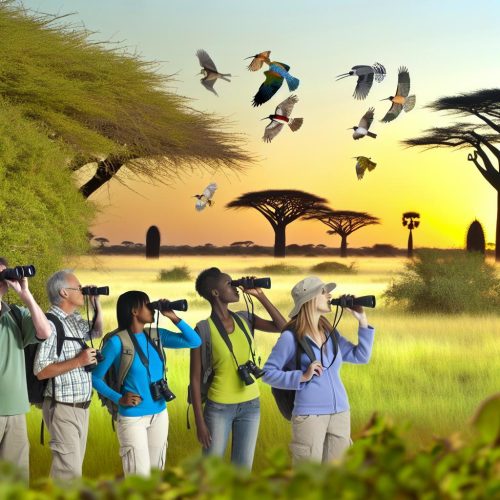Introduction to Birdwatching Safaris
Birdwatching safaris offer enthusiasts unique opportunities to observe and study a plethora of bird species in their natural habitats. Unlike traditional safaris, which primarily center around large mammals such as lions, elephants, and giraffes, birdwatching safaris bring the intricate and diverse world of birds into the spotlight. These excursions cater specifically to those fascinated by the avian diversity that thrives in different parts of the world. Such safaris can vary widely in terms of location, taking place in diverse landscapes across the globe. From the open African savannas to dense tropical rainforests and serene coastal wetlands, each setting provides a unique experience and a chance to view an array of bird species that are specifically adapted to their environments.
Popular Destinations for Birdwatching Safaris
Birdwatching safaris take enthusiasts to some of the most biodiverse regions on the planet. Each area is renowned for its rich birdlife and the incredible encounters it offers. Among the continents, Africa is particularly famed for its extensive variety of birds, with a multitude of countries providing prime locations for these activities.
One prime destination is the **Great Rift Valley** in Kenya, famous for its breathtaking landscapes and lakes populated by vast numbers of flamingos. This region provides a picturesque backdrop for birdwatchers, allowing them to explore areas such as Kenya’s [Maasai Mara](https://www.kenyasafari.com) and the Serengeti, which offer exceptional birdwatching opportunities alongside a chance to see other wildlife.
In South America, the Amazon Rainforest is a famed habitat supporting hundreds of bird species. The diverse ecosystem allows birdwatchers to see unique and rare species. Moreover, the **Pantanal** in Brazil is especially noted for its bird diversity, with open landscapes that make birdwatching easier and more rewarding. South America’s appeal continues with Peru and Ecuador, countries celebrated for their Andean cloud forests. These forests provide habitats for birds that thrive in more elevated and cloud-rich environments, granting birdwatchers unique viewing opportunities in lush greenery.
Essential Gear for Birdwatching Safaris
Venturing on a birdwatching safari requires some essential equipment to ensure a fulfilling experience. At the top of the list is a robust pair of binoculars. This tool is crucial for birders as it allows detailed observations from a distance, which is essential to avoid disturbing the birds’ natural activities. Quality binoculars with a suitable magnification power essentially bring the bird up close and personal without physically invading its space.
A field guide book, either in physical form or accessible through a birdwatching app, is another vital item. This guide helps identify various species during the safari, enhancing the learning experience and understanding of the region’s avian inhabitants. A quality camera equipped with a telephoto lens can also be indispensable. It enables enthusiasts to capture the essence of birds in their natural surroundings, creating lasting memories and contributing to personal avian photography collections.
When it comes to attire, wearing neutral-colored clothing is advisable. Clothing that blends into the natural environment allows birdwatchers to avoid drawing attention and minimizes disruptions in the area. Thus, birdwatchers can observe birds acting naturally without causing stress or fleeing. Additionally, comfortable and durable footwear is a must-have. Birdwatching safaris typically involve substantial walking across rough or uneven terrain, making proper footwear important to ensure comfort and safety throughout the adventure.
Conservation and Ethical Birdwatching
An integral part of birdwatching safaris is understanding and promoting the conservation of bird species and their habitats. The growing threats from habitat loss, climate change, and various human activities mean that many bird species are at risk, making conservation efforts more crucial than ever. Birdwatchers can actively aid these efforts by selecting tour operators committed to responsible and sustainable practices. Choosing operators who contribute to local conservation projects can significantly impact preserving bird populations and their habitats.
Additionally, adhering to ethical guidelines during birdwatching is essential. Maintaining a respectful distance from the birds allows them to carry on with their routines unimpeded by human presence. It’s also important to avoid disturbing the environment, particularly avoiding damage to vegetation and respecting nesting sites. Birdwatchers are encouraged to follow the birdwatcher’s code of ethics, ensuring they respect both the environment and the avian inhabitants.
Conclusion
Birdwatching safaris provide unparalleled opportunities to delve into the world of avian life within its natural framework. These safaris not only offer engaging ways for individuals to immerse themselves in nature but also serve as reminders of the critical role each person plays in preserving the planet’s biodiversity. By carefully selecting destinations, equipping themselves with indispensable gear, and adhering to ethical practices, birdwatchers can enjoy enriching experiences. These experiences contribute significantly to conservation efforts, ensuring that future generations will also have opportunities to cherish and explore these magnificent creatures.
Engage deeply with each environment visited, respect every bird encountered, and observe the fascinating behaviors of these winged wonders that fill our skies. By partaking in birdwatching safaris, each enthusiast plays a role in safeguarding not just the birds but the vital ecosystems that support them. It’s a journey not just across picturesque landscapes but also towards fostering a deeper commitment to conservation on a global scale.
